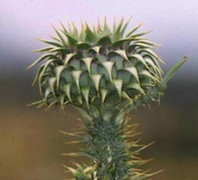
Intensive cultivation of the plant began in earnest three years ago in the agricultural region of Kozani, in Northern Greece, which is home to a lignite production plant managed by PPC, the Greek electrical energy company, which is also the main buyer of thistle harvests. The aim of the experiment was to produce a plentiful biomass able to be mixed with lignite and burned, reducing environmental pollution and contributing to the economy in the area.
“Cultivation for the production of biomass to be combined with lignite began to contribute to the green economy and to the sustainable management of electrical production in this region,” George Dakis, the governor of West Macedonia, recently told the Kathimerini newspaper. Plantations were financed for a period of two years, with farmers paid 200 euros for every 10 ares (1,000 square metres) in which thistles were planted. The offer was so attractive that dozens of farmers signed up to the project and began to grow thistles over a total area of 400 hectares (4 square kilometres).
Five tonnes obtained from the first yield were sent to a German laboratory, which examined the quality of the plant, while the first experiment of the combustion of 50 tonnes of dried thistle biomass was successfully carried out in PPC’s Kozani plant in October 2009. Growers were happy with the results, which made the promise of excellent economic prospects a reality, but so was the PPC, as the company could finally claim that it was working to conform to European standards for the production of green energy.
The following September, the PPC plant in Kozani received a load of 1,800 tonnes of dried thistles, which was burned in a mixture containing 8-10% of lignite. At the time, the PPC fixed a market price of 51 euros per tonne of dried thistle. After further experiments, all of them successful, involving the combustion of combined lignite and thistles, PPC committed itself on October 15 2010 to continuing to feed the Kozani plant, leading many other farmers in the area to dedicate themselves to the promising cultivation of “wild artichokes” instead of traditional cotton growing which, amongst other factors, needs a large amount of water.
At the beginning of this year, however, due to alleged “bureaucratic problems”, PPC was unable to fix the market price at which it intended to purchase thistles. This delay was compounded by the fact that thistle growing is no longer financed, and resulted in a significant reduction in the amount of land cultivated, which fell from 400 hectares in 2010 to around 115 (just over one square kilometre) today.
The farmers who hastily abandoned thistle growing for fear of not earning enough could hardly have predicted it, but only a few days ago, the PPC announced that this year’s thistle yield could raise more than 70 euros per tonne. The authorities in the Macedonia area, meanwhile, are confident that farmers in the region will resume planting thistles once the PPC’s bureaucratic problems have been resolved.
Researchers at the University of Thessaly say that the use of thistles for the production of electrical energy on the Greek islands not only represents a source of income for thousands of farmers, but could lead to savings on combustibles of 500 million euros per year.
See all the latest news from Greece and the world at Greekreporter.com. Contact our newsroom to report an update or send your story, photos and videos. Follow GR on Google News and subscribe here to our daily email!



